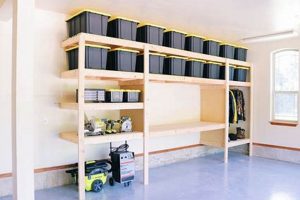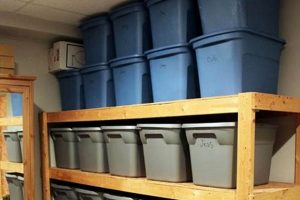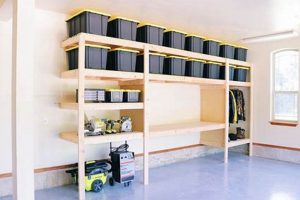Structures designed to hold containers for organizing items are often constructed by individuals to meet specific spatial needs and budgetary constraints. These self-made organizational systems provide a customizable approach to storage, often utilizing readily available materials and basic construction techniques. For example, a homeowner might build a tiered shelving unit in a garage to house plastic bins containing seasonal decorations.
The construction of personalized storage solutions offers benefits such as optimized space utilization, cost-effectiveness, and the satisfaction of a hands-on project. Historically, the practice of creating tailored storage has evolved from simple shelving made of rough-hewn lumber to more sophisticated designs incorporating metal, plastic, and composite materials. The ability to customize dimensions and configurations makes this a popular choice for those with unique storage challenges or specific aesthetic preferences.
Subsequent sections will detail the diverse range of design options, material considerations, and construction methods applicable to creating these personalized storage solutions. Furthermore, factors such as safety, load-bearing capacity, and long-term durability will be addressed to ensure successful implementation.
Construction Guidelines for Storage Container Housing
The following recommendations provide guidance for building durable and effective storage solutions. Adherence to these principles contributes to a safe and organized storage environment.
Tip 1: Prioritize Structural Integrity: Select materials appropriate for the anticipated load. Reinforce joints with screws or bolts rather than relying solely on adhesives to prevent collapse. For heavier items, consider using metal supports or thicker lumber.
Tip 2: Precise Measurement and Planning: Accurately measure the dimensions of the storage containers before commencing construction. This ensures a snug fit and prevents wasted space. Create a detailed plan or blueprint that accounts for all dimensions and material requirements.
Tip 3: Implement Leveling Techniques: Ensure that all horizontal surfaces are perfectly level. Use a spirit level during construction and make adjustments as needed. Uneven surfaces can cause containers to shift or tip over.
Tip 4: Optimize Vertical Space: Design the structure to maximize the use of vertical space. Adjustable shelving or tiered designs allow for flexible storage configurations. Consider the reach height of users when determining shelf placement.
Tip 5: Consider Accessibility: Design the structure to allow for easy access to containers. Ensure sufficient clearance around the unit for maneuvering and removing containers. Labeling containers can also improve accessibility.
Tip 6: Protect Against Moisture: If the storage solution is located in a damp environment, use moisture-resistant materials or apply a protective sealant. This will prevent deterioration and protect stored items from damage.
Tip 7: Ensure Proper Ventilation: If storing items that may emit odors or require ventilation, incorporate ventilation into the structure. This can be achieved through the use of perforated panels or strategically placed openings.
By implementing these guidelines, individuals can create robust and functional storage container housing that meets their specific needs. Careful planning and execution are essential for ensuring the safety and longevity of the structure.
The subsequent discussion will address common challenges encountered during the building process and strategies for overcoming them.
1. Material Selection
Material selection significantly influences the functionality and longevity of self-constructed storage container housing. The choice of materials dictates the structure’s load-bearing capacity, resistance to environmental factors, and overall durability. Inadequate material selection can result in structural failure, premature degradation, or safety hazards. For instance, using untreated softwood in a damp environment will likely lead to rot and collapse, while employing lightweight plastic for heavy containers risks deformation and instability.
Proper material selection involves considering the weight and nature of the items to be stored, the environmental conditions of the storage location, and the desired aesthetic. Solid wood, such as pine or oak, offers robust support for heavier loads and can be stained or painted to match existing decor. Metal, in the form of steel or aluminum, provides exceptional strength and is resistant to moisture and pests, making it suitable for garages or outdoor storage. Composite materials offer a balance of durability and affordability, but require careful consideration of their load-bearing capabilities and resistance to weathering. A practical example is the construction of garage shelving; opting for steel frames with plywood shelves ensures stability and prevents sagging under the weight of heavy tools and equipment.
Therefore, careful consideration of material properties and their suitability for the intended application is paramount. Understanding the cause-and-effect relationship between material choice and structural integrity is essential for creating safe, effective, and long-lasting storage container housing. Ultimately, selecting the appropriate materials contributes directly to the overall success and utility of the organizational system, minimizing the risk of future repairs or replacements.
2. Structural Stability
Structural stability represents a critical engineering principle in the context of self-constructed container storage systems. Ensuring the integrity of such systems is paramount to prevent collapse, protect stored items, and maintain user safety. The following outlines key facets of structural stability as applied to the design and construction of these storage solutions.
- Load Distribution
Load distribution refers to the manner in which weight is transferred throughout the structure. Uneven distribution can concentrate stress on specific points, leading to failure. Proper design necessitates distributing weight evenly across all supporting members, utilizing techniques such as reinforced joints and adequately sized supports. For example, a shelf designed to hold multiple heavy bins requires supports positioned to evenly distribute the load across the shelf’s length, preventing sagging or breakage.
- Material Strength and Selection
The inherent strength of the chosen materials directly influences the structure’s capacity to withstand applied loads. Different materials possess varying degrees of tensile and compressive strength. Selecting materials appropriate for the anticipated weight is essential. For instance, solid wood or steel framing offers greater load-bearing capacity compared to lightweight plastics or particleboard. The material’s resistance to environmental factors, such as moisture, is also crucial for long-term stability.
- Joint Integrity
Joints represent critical points of potential failure in any structure. The method of joining structural members, such as using screws, bolts, or adhesives, significantly impacts the joint’s strength and resistance to stress. Properly reinforced joints, using techniques like gussets or metal brackets, enhance the overall stability of the system. Consider a corner joint on a shelving unit: a simple butt joint held together by nails alone is significantly weaker than a mortise and tenon joint secured with adhesive and mechanical fasteners.
- Bracing and Reinforcement
Bracing and reinforcement techniques are employed to enhance the structural rigidity and prevent deformation. Diagonal bracing, for example, provides resistance to lateral forces, such as those encountered during earthquakes or accidental impacts. Reinforcing vulnerable areas with additional support members, like adding a center support to a long shelf, prevents sagging and maintains structural integrity over time. These additions contribute significantly to the overall robustness of the storage system.
These facets collectively underscore the importance of a comprehensive understanding of structural principles in the creation of stable and reliable container storage solutions. Adherence to these considerations mitigates the risk of failure and ensures the long-term utility and safety of the constructed system. Neglecting these principles can result in compromised structural integrity, potentially leading to property damage and personal injury.
3. Space Optimization
Space optimization, in the context of self-constructed container storage units, is the strategic employment of design principles and construction techniques to maximize storage capacity within a given physical footprint. The connection between these two concepts stems from the inherent need to efficiently utilize available space, particularly in environments where square footage is limited or at a premium. The construction of personalized container holding systems provides a means to tailor storage solutions to specific spatial constraints, thereby enhancing organization and accessibility while minimizing wasted area. An illustrative example is the design of vertical shelving systems in small apartments, where floor space is limited. These structures utilize height to increase storage volume, effectively optimizing the available area for housing various items.
Custom-built solutions allow for exploiting underutilized areas, such as corners, wall recesses, or spaces beneath staircases. By precisely measuring and adapting the dimensions of storage units to fit these unconventional spaces, individuals can create tailored storage solutions that seamlessly integrate into the existing environment. This approach contrasts with pre-fabricated units, which often lack the flexibility required to fully utilize irregularly shaped or constrained areas. The use of modular designs further contributes to space optimization, enabling the configuration and rearrangement of storage components to adapt to evolving storage needs. For instance, modular shelving units can be reconfigured or expanded as storage requirements change, providing a dynamic and adaptable organizational system.
The practical significance of understanding the relationship between space optimization and self-constructed container housing lies in the ability to create efficient, functional, and aesthetically integrated storage solutions. Challenges may include accurately assessing spatial dimensions and selecting appropriate materials to support the intended load. Overcoming these challenges through careful planning and execution results in storage systems that maximize available space, enhance organization, and contribute to a more efficient and aesthetically pleasing living or working environment. The understanding of this relationship transforms the creation of storage from a simple construction task into a strategic spatial planning endeavor.
4. Load Capacity
Load capacity, in the context of self-constructed container storage solutions, represents the maximum weight a structure can safely bear without compromising its structural integrity. The relationship between load capacity and these solutions is fundamental; a failure to accurately assess and accommodate anticipated loads can lead to structural failure, resulting in damage to stored items and potential safety hazards. For instance, constructing a shelving unit designed to house heavy tools using insufficiently strong materials could result in the shelves collapsing under the load. The accuracy of load capacity calculations is vital for preventing such occurrences, emphasizing the need for careful planning and material selection based on anticipated weight distribution.
Consider the real-world example of building shelving for storing books. Books represent a substantial weight per unit volume. A design incorporating thin plywood and insufficient support structures will likely sag or collapse under the sustained weight of a fully loaded bookshelf. Conversely, employing thicker lumber, reinforced joints, and strategically placed vertical supports will distribute the load more effectively, significantly increasing the shelving unit’s capacity and lifespan. Another example is storing automotive parts in garage container setups. These items are often dense and heavy, requiring robust materials such as steel or thick-gauge lumber to withstand the considerable weight without deformation or failure. The structural integrity of these storage arrangements is directly related to the appropriate estimation and accommodation of the stored items’ mass.
The practical significance of understanding load capacity in self-constructed storage units resides in the ability to create safe, durable, and effective organizational systems. Underestimation of load requirements compromises structural integrity; overestimation may lead to unnecessary expenditure on materials. Careful consideration of material properties, construction techniques, and anticipated load distributions is therefore essential for successful construction. By properly calculating and accounting for load capacity, individuals can construct storage solutions that meet their specific needs while maintaining safety and maximizing resource efficiency, thereby mitigating the risks associated with structural failure and ensuring the longevity of the system.
5. Accessibility
Accessibility, in the context of self-assembled storage container housings, refers to the ease with which items can be retrieved from or placed within the system. The operational utility of such systems is directly influenced by the accessibility afforded by their design and construction. Ineffective accessibility can negate the organizational benefits of storage containers, rendering stored items effectively inaccessible and defeating the purpose of systematic storage. A real-world example is a shelving system positioned in a dimly lit, cramped corner of a garage. Though the containers are neatly arranged, the restricted physical access and poor visibility hinder the efficient retrieval of desired items, diminishing the overall value of the storage system.
Optimizing accessibility involves considering factors such as shelf height, aisle width, container placement, and labeling strategies. Shelves positioned too high or too low require excessive reaching or bending, increasing the risk of strain or injury. Insufficient aisle width restricts movement and maneuverability, impeding access to containers located at the rear of the system. Containers placed haphazardly without a discernible organizational logic necessitate a time-consuming search for specific items. Clear and concise labeling, on the other hand, facilitates rapid identification and retrieval. For example, labeling containers with bold, easily readable font allows users to quickly locate desired items without having to open multiple containers. Furthermore, implementing a rotation system for stored items, placing frequently used items within easy reach and less frequently used items in less accessible locations, optimizes the efficiency of the system.
In summary, the degree to which the assembled storage system allows for easy and efficient access to its contents is pivotal to its effectiveness. Poor accessibility not only defeats the purpose of organizing storage items, but also poses safety concerns for their retrieval. Conversely, well-thought-out design ensures both efficient operation and a reduced risk of injury or frustration. Consequently, the accessibility of storage solutions is not merely a convenient add-on but a fundamental design characteristic that directly impacts the practicality and overall success of storage container arrangements.
6. Safety Protocols
Adherence to safety protocols is paramount when constructing self-assembled container housing. These protocols are not merely suggestions, but rather essential safeguards to mitigate potential hazards associated with construction, installation, and subsequent usage. Failure to observe appropriate safety measures can lead to structural failure, personal injury, or property damage. The following outlines critical safety considerations for individuals undertaking these projects.
- Personal Protective Equipment (PPE)
The consistent use of appropriate PPE is critical for preventing injuries during the construction phase. This includes safety glasses to protect against debris, gloves to prevent cuts and abrasions, and sturdy footwear to minimize the risk of foot injuries. Depending on the tools and materials used, respiratory protection may also be necessary to avoid inhaling dust or fumes. Example: Sawing lumber requires safety glasses and a dust mask to prevent eye irritation and respiratory problems. The implications are direct: PPE significantly reduces the likelihood and severity of injuries resulting from common construction activities.
- Structural Integrity Assessment
Prior to placing any load on the assembled storage unit, a thorough assessment of its structural integrity is essential. This involves visually inspecting all joints, supports, and connections to ensure they are properly secured and aligned. Any signs of weakness or instability should be addressed before loading the unit. Example: Checking that screws are securely fastened and that shelves are level prevents potential collapses. The implications include minimizing the risk of sudden structural failure, protecting stored items, and preventing potential injury to individuals.
- Load Distribution Awareness
Understanding and adhering to appropriate load distribution principles is vital for maintaining stability and preventing overstressing individual components of the storage unit. Heavy items should be placed on lower shelves, and weight should be distributed evenly across each shelf to avoid concentrated stress points. Example: Placing heavy boxes of books on the bottom shelf and lighter items on the top shelf. The implications are that balanced load distribution prevents localized stress, ensuring the long-term stability and preventing structural failure.
- Secure Mounting and Anchoring
To prevent tipping or accidental displacement, particularly in areas prone to seismic activity or high traffic, the storage unit should be securely mounted to the wall or floor. This involves using appropriate anchors and fasteners suited to the wall or floor material. Example: Attaching a tall shelving unit to a wall stud using lag screws prevents it from tipping over. The implications of secure mounting and anchoring are enhanced stability, reduced risk of accidents, and increased protection for stored items and individuals in the surrounding area.
These safety protocols, while not exhaustive, represent fundamental considerations for individuals engaged in self-constructing container storage solutions. By prioritizing safety and adhering to established guidelines, one can significantly reduce the risk of accidents and ensure the creation of functional and durable storage systems. The consistent application of these protocols transforms storage construction from a potentially hazardous activity into a safe and productive endeavor, thereby realizing the benefits of customized organization while safeguarding well-being.
7. Cost-Effectiveness
Cost-effectiveness represents a primary motivating factor for individuals undertaking self-constructed storage container solutions. This approach often presents a viable alternative to commercially available storage systems, offering the potential for significant cost savings while enabling customization to specific needs and spatial constraints. The ability to source materials and control labor inputs directly influences the overall economic feasibility of these projects.
- Material Sourcing and Optimization
Material sourcing strategies significantly impact the overall cost. Utilizing reclaimed lumber, repurposed materials, or purchasing materials in bulk can substantially reduce expenses compared to purchasing pre-fabricated units. Example: Reusing pallets or salvaged wood to construct shelving can lower material costs considerably. This facet emphasizes the direct relationship between material choices and overall project affordability.
- Labor Input and Skill Level
The cost-effectiveness is also tied to the labor involved. Individuals with existing carpentry skills or a willingness to learn can significantly reduce expenses by eliminating professional labor costs. However, it’s essential to realistically assess one’s skills to avoid costly mistakes or project abandonment. Example: A complex design requiring specialized tools or advanced techniques might ultimately be more expensive than purchasing a pre-made unit if professional assistance becomes necessary. The degree of labor input directly influences cost, underscoring the importance of skill assessment and realistic project scope.
- Customization vs. Standardization
The ability to customize dimensions and configurations offers a unique advantage in terms of space utilization and tailored storage. However, highly customized designs can increase material waste and labor time, potentially offsetting cost savings. Standardized designs, while less adaptable, often offer a more efficient use of materials and simpler construction. Example: Building a storage unit specifically designed to fit an awkward alcove may require more intricate cutting and fitting, increasing material waste. Balancing customization with standardized elements is crucial for achieving optimal cost-effectiveness.
- Long-Term Durability and Maintenance
A cost-effective solution must also consider long-term durability and maintenance requirements. Selecting durable materials and employing sound construction techniques can minimize the need for future repairs or replacements, ultimately reducing the overall cost of ownership. Example: Using pressure-treated lumber for outdoor storage can prevent rot and extend the lifespan of the structure, reducing long-term maintenance costs. Focusing on durability ensures sustained value and prevents recurring expenses.
In conclusion, the economic viability of self-constructed container housing rests on a careful assessment of material sourcing, labor inputs, customization requirements, and long-term durability considerations. Individuals undertaking these projects must strike a balance between achieving desired functionality and minimizing expenses to realize the full potential of cost-effectiveness. A holistic approach, encompassing both initial construction costs and long-term ownership expenses, is crucial for maximizing the economic benefits of these personalized storage solutions.
Frequently Asked Questions
The following questions address common concerns and considerations regarding the design, construction, and implementation of self-assembled container housing units.
Question 1: What materials are most suitable for constructing durable storage container frameworks?
The optimal materials depend on the intended load and environmental conditions. Solid wood, such as pine or oak, offers robust support for heavier loads. Metal, such as steel or aluminum, provides exceptional strength and moisture resistance. Composite materials offer a balance of durability and affordability but require careful load-bearing assessment.
Question 2: How can the structural stability of self-constructed shelving systems be ensured?
Ensuring structural stability requires attention to load distribution, material selection, joint integrity, and bracing. Weight should be evenly distributed, materials should be chosen based on strength requirements, joints should be reinforced with screws or bolts rather than solely relying on adhesives, and bracing can enhance rigidity and prevent deformation.
Question 3: What methods effectively maximize space utilization in small or constrained areas?
Maximizing space utilization involves exploiting underutilized areas, such as corners or spaces beneath staircases. Vertical shelving systems efficiently use height to increase storage volume. Modular designs enable reconfiguration and adaptation to evolving storage needs. Precise measurements and tailoring dimensions to fit unconventional spaces are crucial.
Question 4: How is the safe load capacity of a self-built storage unit accurately determined?
Determining load capacity requires careful consideration of material properties, construction techniques, and anticipated load distributions. Material specifications provide information on their strength. Proper joint construction is essential. Weight should be distributed evenly across the unit to avoid concentrated stress points.
Question 5: What design elements enhance the accessibility of containerized storage?
Optimizing accessibility involves considering shelf height, aisle width, container placement, and labeling. Shelves should be positioned within easy reach, aisle width should allow for maneuverability, containers should be organized logically, and clear labeling facilitates rapid identification and retrieval.
Question 6: What fundamental safety precautions should be observed during the construction and use of storage units?
Observing fundamental safety precautions necessitates the consistent use of personal protective equipment, thorough structural integrity assessment, adherence to appropriate load distribution principles, and secure mounting and anchoring of the storage unit to prevent tipping or displacement.
These frequently asked questions highlight the critical factors to consider when designing and building storage container housings. Proper planning, material selection, and construction techniques are essential for creating safe, durable, and effective storage solutions.
The subsequent section will address potential challenges and solutions encountered during the construction process.
DIY Storage Bin Racks
The preceding analysis has illuminated the critical design, construction, and safety considerations inherent in creating organizational solutions for storage containers. From material selection to structural integrity and space optimization, each element contributes directly to the functionality, durability, and long-term utility of such systems. The successful implementation relies on meticulous planning, precise execution, and a thorough understanding of the principles of load-bearing capacity and safety protocols.
Given the potential for cost-savings and customization, the construction of personalized storage options presents a viable alternative to commercially available units. A dedication to best practices, including material selection, structural and safety parameters, will ensure the construction of robust, safe, and efficient storage solutions. Failure to comply with the recommendations discussed herein can lead to structural failure, potential injury, or compromised storage integrity.







